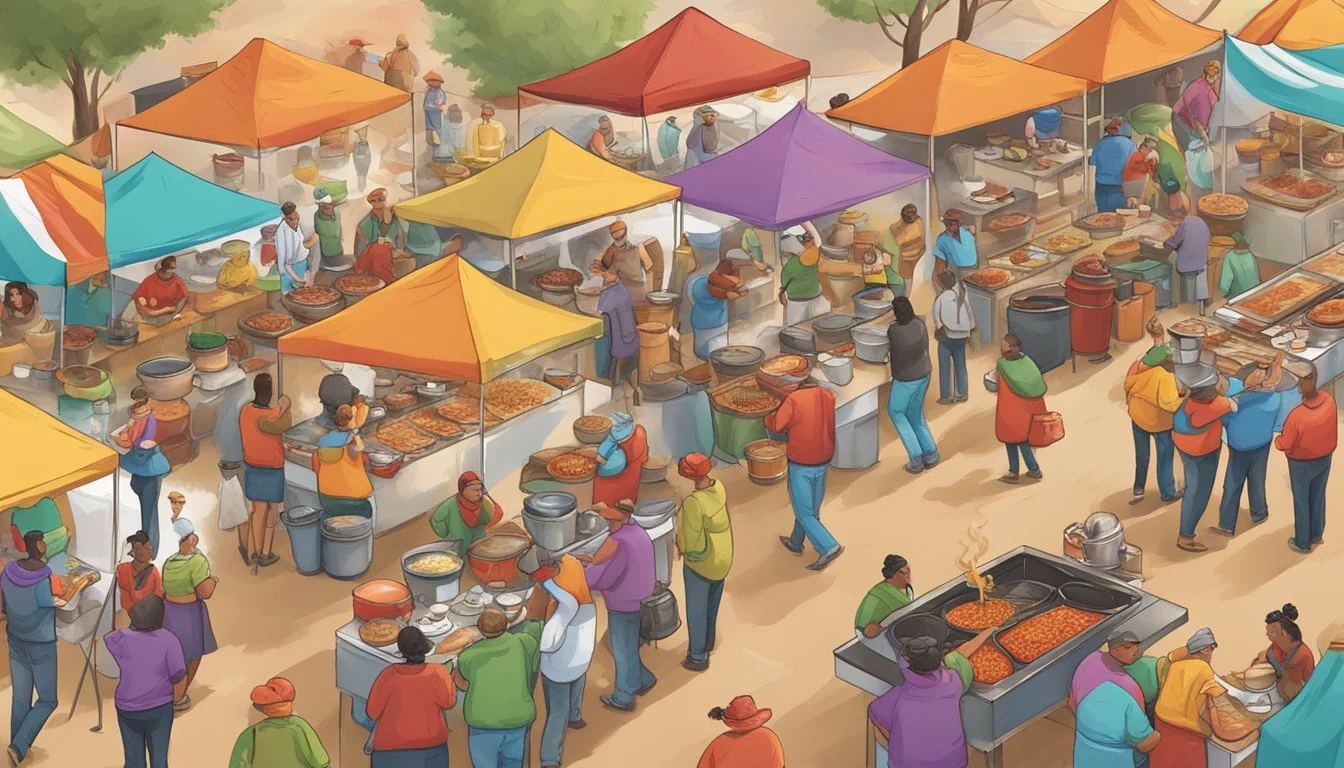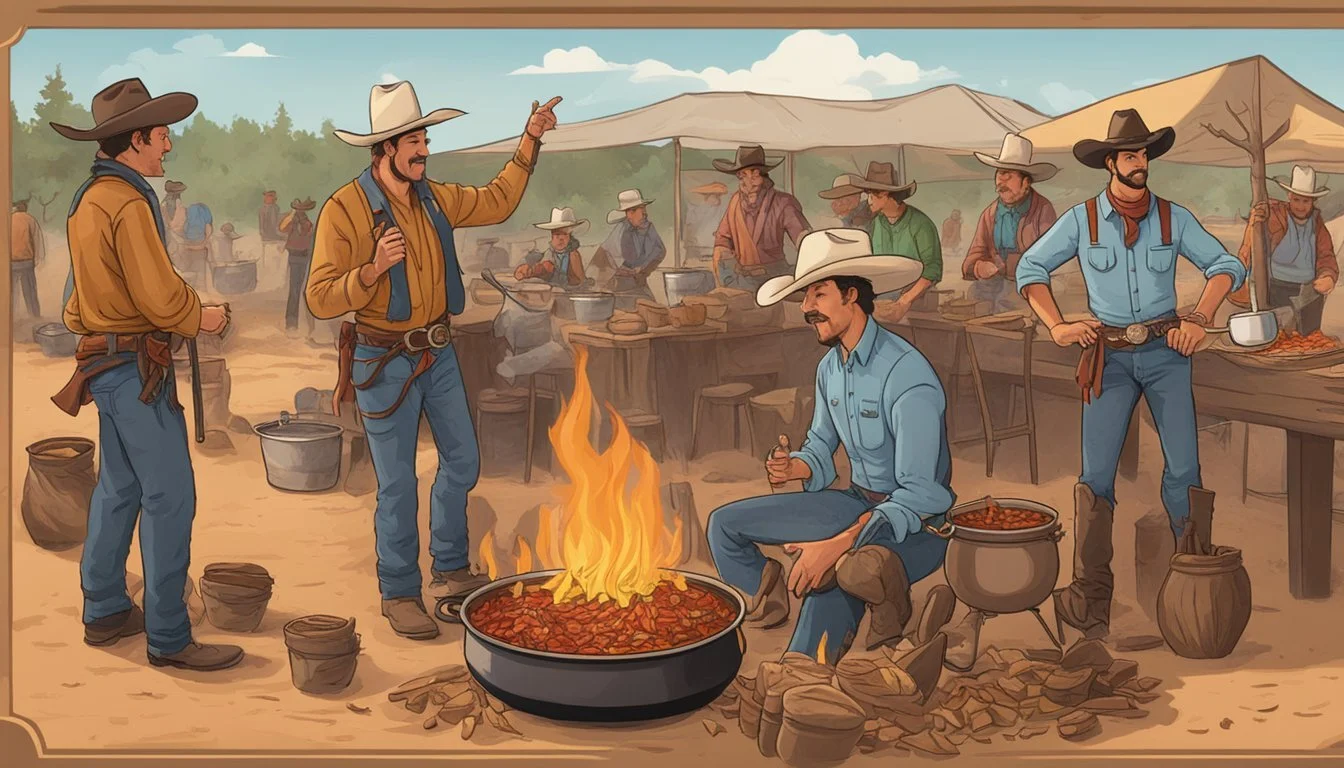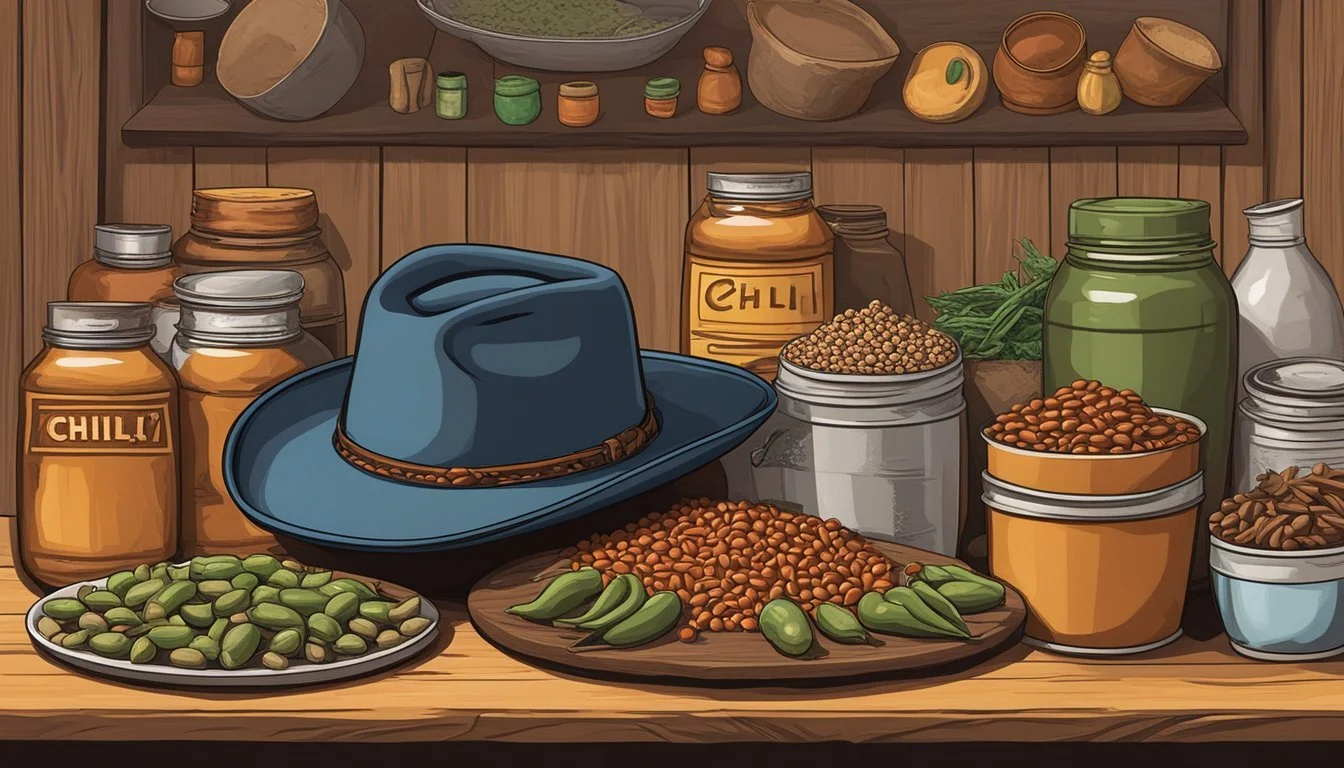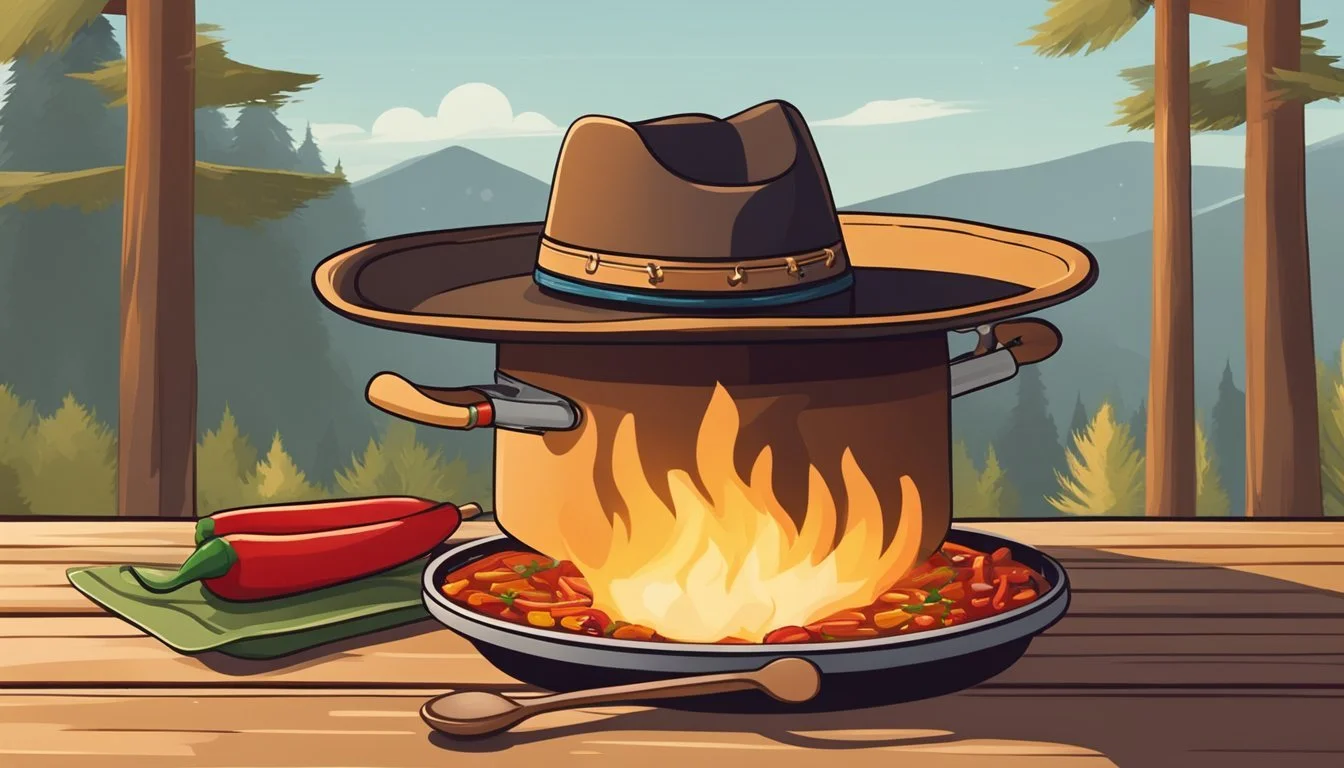The Texas Cowboy's Guide to Chili Cook-Offs
Mastering the Competition Circuit
Texas has long been heralded as the heartland of chili cook-offs, where the spirit of competition and community merge over steaming pots of the state dish. These cook-offs aren't merely about the heat of the chili but about the joy and camaraderie that emerge when people gather to celebrate a culinary tradition that’s as rich and varied as the state itself. The gatherings are as much social occasions as they are culinary battles, with attendees often describing the atmosphere as electric, uniting individuals from all walks of life in their shared love for a good bowl of red.
Chili cook-offs in Texas are serious business, with cooks often preparing their recipes for weeks or even months in advance. They are events where the expertise of the participants is paramount, and the specific preparation methods can lead to heated debates as enthusiastic as the competitions themselves. The stringent rules of cook-offs ensure that the chili is the star of the show and craft such as the Original Terlingua International Championship Chili Cookoff have become legendary gathering points for both aficionados and casual fans alike.
These events transcend the boundaries of a mere food competition; they foster a sense of belonging and pride in a tradition that reflects the state's diverse cultural history. Traditional chuckwagon influences mix with Mexican, Native American, and European flavors, creating a culinary backdrop that accurately portrays the melting pot that is Texas. Competing or simply spectating at a Texas chili cook-off offers an authentic taste of the state's history and is an experience that attracts visitors from far and wide.
The History and Culture of Texas Chili
Texas chili represents a robust tradition infused with the state's diverse heritage. This spicy stew not only embodies the spirit of Texan cuisine but also showcases the cultural tapestry woven by pioneers and indigenous peoples.
Origins of Texas Chili
The birth of Texas chili can be traced back to the early days of San Antonio in the 1800s, where it started as a simple, hearty dish among the working class. San Antonio's Chili Queens, women who sold the dish at Military Plaza as early as the mid-1800s, popularized chili by preparing it at home and bringing it to the square to sell. This practice continued well into the mid-20th century until health regulations changed the landscape of street food vending.
Influence of Pioneers and Native American Traditions
Texas chili's evolution is indivisible from the contributions of early German and Czech settlers and Native American traditions. These groups introduced ingredients and methods that became staples:
Pioneers: Used portable, dried beef, suet, and chili peppers, essential during long cattle drives.
Native Americans: They influenced the use of spices and cooking techniques, enhancing the dish's flavor and complexity.
The seamless melding of these influences has perpetuated a unique chili culture, grounded in the seasonality of chili peppers and the hardiness required by frontier life.
The Role of Chili in Texas Festivals
Chili in Texas is more than a dish; it's a competitive craft celebrated in festivals across the state. Terlingua, a small town in Texas, is home to one of the most famous chili cook-offs, where enthusiasts revel in the art of chili-making. These festivals serve as gatherings that bolster community spirit and honor the deep-seated tradition of Texan chili. Venues pivot around competitions that highlight the flavors and innovations distinctive to various regions within Texas.
Understanding Chili Cook-Offs
Chili cook-offs are vibrant events showcasing culinary skills and community spirit. They are meticulously organized competitions where enthusiasts and professionals alike present their best chili to be judged on taste, consistency, aroma, and color.
The Anatomy of a Cook-Off
A typical chili cook-off involves preparing chili on-site by competitors, who adhere to strict guidelines to create their best rendition of the dish. These events can range from small, local gatherings to large, internationally recognized championships. The cook-off structure often includes:
Preparation: Competitors set up their cooking stations with all necessary ingredients and equipment.
Cooking: Contestants have a set amount of time to cook their chili from scratch.
Judging: A panel of judges, usually from the chili appreciation societies like the International Chili Society (ICS) or Chili Appreciation Society International (CASI), evaluate each entry.
Various Types of Competitions
Competitions can vary dramatically, from the classic traditional red chili to specific categories like chili verde or salsa. A list of some competition types includes:
Traditional Red Chili: Beef and sauce with no fillers like beans or pasta.
Chili Verde: Green chili featuring pork and green chili peppers.
Salsa: A separate category for those who excel in crafting the perfect chili accompaniment.
Homestyle Chili: A less restrictive category, often includes beans or other ingredients.
Different competitions have unique rules, and some may follow the guidelines set by the ICS or CASI. These entities often sanction prominent events, ensuring a standardized judging process.
Key Roles: Competitors, Judges, and Attendees
Competitors: They are the heart of the cook-off, investing time and creativity to produce unique chili recipes.
Judges: Tasked with the critical role of evaluating chili entries, judges bring impartiality and expertise to the table. They sample each chili entry blindly to ensure fairness.
Attendees: Not only are they there to enjoy the festival atmosphere and taste chili, but they also often get to participate in public voting for categories like the "People's Choice."
Chili cook-offs, like Texas' own Terlingua Chili Cook-off, often have more than just cooking competitions—they may also include live music, crafts, and other festival activities, contributing to the overall experience for competitors and attendees alike.
Preparation for the Competition
A successful chili cook-off contestant knows that meticulous preparation and the finest ingredients form the foundation of an award-winning chili. Here, we outline the practical steps and ingredient choices every aspiring Texas cowboy should consider.
Essentials of Chili Preparation
To prepare for a chili cook-off, contestants must ensure they have a detailed plan of action. This includes confirming the cook-off rules, gathering necessary equipment, and practicing the chili recipe. Chili preparation demands the right balance of spices and a cooking process that melds flavors harmoniously. They should be well-versed in adjusting cooking times and heat levels according to the ingredients' behaviors, ensuring a perfectly cooked chili every time.
Essential cooking equipment can be summarized as follows:
Cookware: Large pot for cooking chili, preferably a heavy-duty choice like cast iron.
Utensils: Wooden spoons, knives, measuring cups and spoons.
Storage: Coolers or portable refrigerators for keeping ingredients fresh.
Safety: Thermometers for monitoring food temperatures – ingredients should be stored at 41 degrees Fahrenheit or below, while cooked chili should be maintained at 140 degrees Fahrenheit or above.
Selecting Quality Ingredients and Spices
A top-tier chili's flavor hinges on the quality of its ingredients and the blend of spices used. Fresh, high-quality meat is essential; beef is traditional, ground or cubed depending on preference. Fresh vegetables like onions and garlic form the flavor base when sautéed, their freshness crucial to the chili's overall taste profile.
Here is a breakdown of two fundamental chili spices:
Cumin: Earthy and slightly bitter, cumin is a staple spice that adds depth.
Chili Powder: A blend of spices including ground chili peppers, it's the heart of chili's flavor, delivering mild to intense heat.
The selection of these spices should be done with care, opting for freshness and potency for a robust flavor profile. The precise use of spices such as cumin and chili powder can heavily influence the outcome of the chili, whether aiming for a smoky, spicy, or savory creation.
Through proper preparation and ingredient selection, a contestant is positioned to craft a chili that not only stands out in flavor but also embodies the authenticity and spirit of Texas cook-offs.
The Culinary Techniques of Chili
The preparation of chili, particularly in the context of Texas chili cook-offs, involves mastering traditional recipes and embracing innovative cooking techniques. Competitors often aim to create a balance between authentic flavors and unique twists to impress the judges.
Traditional Texas Chili Recipes
In Texas, the quintessence of chili—often referred to as Texas Red—relies on simple, robust ingredients cooked with precision. Traditional Texas chili inherently excludes beans and tomatoes; it focuses on meat, typically beef, which is slow-cooked to achieve a deep, concentrated flavor. The meat is hand-cut into cubes rather than ground, underscoring the chili's hearty texture.
Key Ingredients for Traditional Texas Chili:
Beef, usually chuck cut into chunks
Assorted chili peppers (e.g., ancho, pasilla, jalapeño)
Spices: cumin, chili powder, paprika
Garlic and onions for foundational flavors
Beef stock or water as the liquid component
For a genuine Texas chili, the cooking process is as critical as the ingredients. The beef is browned in a heavy pot; following this, onions and garlic are sautéed until softened. Then, spices are stirred in and cooked briefly to release their aromatics. Water or beef stock is added before the mixture is brought to a slow simmer. This technique ensures that the flavors meld together over several hours, resulting in a chili with a rich, complex profile that highlights the core ingredients without overpowering them.
Innovative Cooking Techniques
The artistry of chili in competitions often lies in a cook's ability to introduce innovative cooking techniques that elevate the dish. Competitors seek to maintain the essence of traditional Texas chili while embedding their creation with unique flavors that differentiate it from others.
Examples of Innovative Techniques:
Utilizing a variety of chilies to create a custom blend of chili powders
Experimenting with unexpected ingredients like cocoa powder or cinnamon for depth
Employing masa harina to thicken the chili and add a subtle corn flavor
Slow cooking or smoking the beef before adding it to the chili to infuse a smoky essence
Innovative cooking techniques can also encompass sophisticated methods of preparation, such as creating a homemade chili paste by pureeing rehydrated chilies with beef stock. By adopting fresh culinary approaches and being willing to step outside traditional boundaries, competitors in chili cook-offs can present a dish that not only respects the roots of Texas chili but also adds a contemporary touch, inviting judges and fellow chili enthusiasts to savor a familiar favorite with renewed interest.
Judging and Winning a Chili Cook-Off
In the competitive landscape of chili cook-offs, judgment pivots on a strict set of criteria, and the victor’s spoils include not just accolades but often tangible rewards.
Criteria for Judging Chili
Judges assess chili based on specific criteria that encompass flavor, color, consistency, aroma, and heat. Each aspect is carefully considered to determine the chili’s quality:
Flavor: Should be well-balanced, where no single ingredient overpowers the others. Judges look for a complex taste profile that demonstrates a symphony of spices.
Color: The chili should have a rich and appealing appearance, indicative of its flavor depth.
Consistency: It's crucial that the chili possesses a hearty texture, neither too thin nor too thick, ensuring all ingredients are distinguishable yet harmoniously combined.
Aroma: A tantalizing scent is key, as it should entice and hint at the flavors to unfold.
Heat: An appropriate level of spiciness is expected; it should be noticeable but not overwhelming.
Scores are often given on a scale of 1 to 10 for each element. The winning chili is the one with the highest cumulative score.
The Thrill of Victory: Prizes and Recognition
Victory at a chili cook-off brings with it not only a badge of honor but also often includes cash prizes and a trophy. Champions can revel in the title and the potential for local, or even national, fame in the chili community. Success in these competitions is a testament to a cook’s culinary skill and can open doors to further gastronomic ventures and invitations to prestigious cook-offs.
Popular Chili Cook-Offs and Competitions
In Texas, chili cook-offs are a storied tradition where culinary skills are showcased and community spirit thrives. Two of the most notable events in the chili calendar are the Original Terlingua International Championship Chili Cookoff and State Fair and Regional Chili Championships, each offering a unique blend of competition, entertainment, and local flavor.
Original Terlingua International Championship Chili Cookoff
The Original Terlingua International Championship Chili Cookoff (OTICCC) is held annually in Terlingua, a small town with a big reputation for chili. This prestigious event is a culmination of chili cook-offs across the nation, where only those who have won other competitions can compete. Set in early November, the OTICCC is a pivotal event for chili enthusiasts seeking to claim top honors in chili mastery.
State Fair and Regional Chili Championships
Regional competitions across Texas serve as qualifiers for larger, more competitive showdowns. At the State Fair of Texas, the Big Tex BBQ and Chili Challenge draws participants from far and wide. The fair typically runs for 24 consecutive days in September and October in Dallas, spotlighting the state's rich culinary arts.
Other regional events such as Czhilispiel in Flatonia, the Pflugerville Pfall Chili Pfest, Chilifest Music Festival near Snook, and the Ladies State Chili Championship of Texas, bring together communities for a celebration of chili. While Czhilispiel, held in late October, is as much a local festival as a cook-off, Pflugerville Pfall Chili Pfest offers a family-friendly environment with chili tasting and live music every October. In Galveston, the competition heats up with the annual World Championship event, attracting competitors from around the globe to compete in chili cooking categories.
Competitions like these not only celebrate the state's unofficial dish but also serve as qualifying events for those looking to make their mark in Terlingua. They reflect the rich culinary heritage of Texas and its love affair with chili, blending a competitive spirit with flavors as big as the state itself.
Community and Entertainment
In Texas chili cook-offs, the vibrancy extends beyond the competition pots; they serve as a hub for communal joy and a showcase of Texas's festive spirit.
Live Music and Entertainment
Texas chili cook-offs are invariably enlivened with live music performances featuring local bands and artists, creating an atmosphere that's as lively as the chili is hot. Whether it's country tunes, rockabilly, or blues, the soundscape is as integral as the food. At these events, the entertainment often comes in many forms, from carnivals with rides and games that appeal to all ages to a lively biergarten offering a selection of beers for a refreshing break between the chili tasting sessions.
Margarita Mix-Off and Other Side Competitions
While chili is the star, a Texas chili cook-off isn't complete without a Margarita Mix-Off. Attendees enjoy the creative concoctions, often voting for their favorite. But the fun doesn't stop there; other competitions such as a Bean Bash, a spirited Washer Tournament, or a tough-as-nails Jalapeño Eating Contest engage participants in the fiercely competitive, yet friendly spirit of Texas. Families often partake in a variety of activities including a whimsical Costume Contest and those looking for some physical activity can join in the festivity of a 5K Run. The community revels together, strengthening ties over shared experiences and the love for chili.
The Future of Chili Cook-Offs
Chili cook-offs in Texas have become a renowned tradition and show no sign of losing their sizzle. They continue to attract competitors and enthusiasts alike, each aiming to leave an indelible mark with their unique concoctions.
Evolving Traditions and Emerging Trends
Evolving Traditions: Texas chili cook-offs are steeped in tradition. However, they are undergoing a transformation. Competitors now experiment with innovative cooking techniques and seasonings to set their chili apart. The community can expect to see more emphasis on unique flavors and heat levels, shifting from the conventional to the contemporary while still respecting the roots of Texas chili.
Emerging Trends: The future will likely see chili without traditional fillers like beans becoming more accepted as chefs focus on the purity of flavor and the quality of their meat. There's also a tendency towards incorporating local, sustainable ingredients which leads to new flavor profiles. Technological advancements in cooking equipment may also enable participants to be more precise in their cooking methods, further elevating the competitive edge at these events.
Texas chili cook-offs are becoming a platform not just for culinary competition but also for innovation and culinary evolution. They offer a visual and gustatory feast that reflects both the state's rich culinary heritage and its dynamic future.






